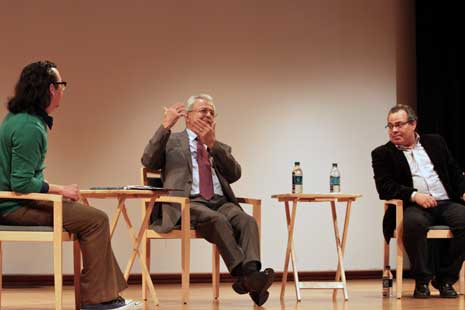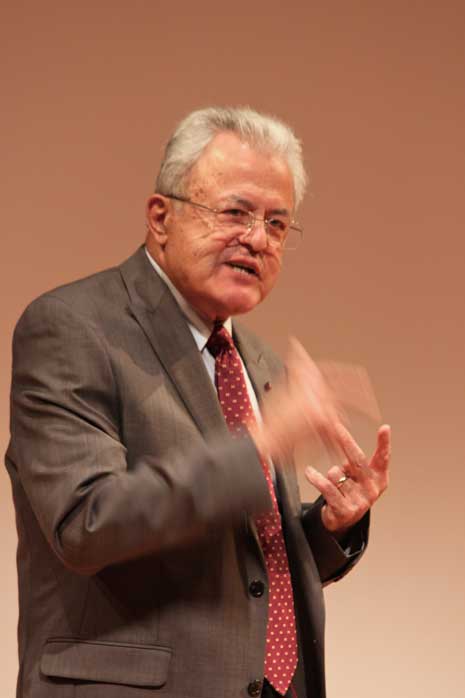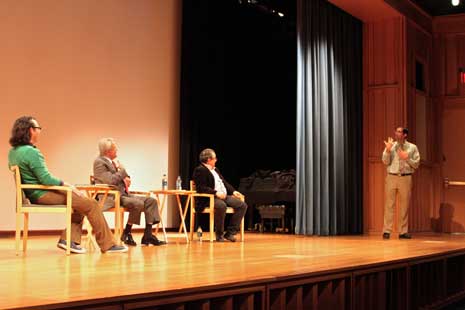Sharing Stories: Deaf Latino Experiences

On Thursday, December 4, the National Portrait Gallery and the Smithsonian Latino Center hosted “Sharing Stories: Deaf Latino Experiences,”an onstage conversation in American Sign Language between former Gallaudet University president Dr. Robert Davila and master storyteller Manny Hernandez. The public program was presented in conjunction with the exhibition “Portraiture Now: Staging the Self” and as part of a series of events celebrating the upcoming twenty-fifth anniversary of the Americans with Disabilities Act. Davila and Hernandez discussed their experiences as deaf Latinos and how they have embraced their identities as minorities within a minority.
Having never before spoken publicly about his life experience as a deaf Latino, Davila described his difficult beginnings working in the plum orchards of California’s Central Valley. At age ten he contracted spinal meningitis, which eventually caused him to become deaf. He attended the California School for the Deaf, where he learned American Sign Language (ASL) and also met the added challenge of learning how to read, write, and speak in English. Davila recalled with poignancy the difficult language divide and how it complicated communication with his family.

Before the Americans with Disabilities Act became law in 1990, disabled citizens routinely faced extreme discrimination in the public sphere, including the workplace and education system. As a Mexican American, Davila faced discrimination because of both his ethnicity and his hearing impairment. He was denied admission to Columbia University owing to doubts about his abilities and fear that his deafness would distract other students. However, Davila maintains that “the best revenge is to succeed.”
He went on to attend Gallaudet University, where he obtained a bachelor’s degree, followed by graduate degrees in education from Hunter College and Syracuse University. He has held various important positions in education and is a prolific speaker on topics related to the empowerment of deaf people.
Born in Brooklyn to parents of Puerto Rican descent, Manny Hernandez has been deaf his entire life. He attended the Lexington School for the Deaf in Jackson Heights and now reaches out to deaf children through storytelling. Hernandez credits his vivid imagination to the comic books he read while growing up, as well as the Broadway plays his uncle would take him to as a child—he was fascinated by the stories even though he couldn’t understand what was being said.

Hernandez has developed his own storytelling style by using sign language to create an interactive, educational environment for his audience. His goal is to engage children and teach them that the topics they study are “relatable and animated.” He also unabashedly draws on his roots: “In Latino culture, gestures form a big part of our language and communication, and I am able to combine that with my sign language.”
Hernandez continues the Latino tradition of passing down oral stories in the visual language of ASL. Like Davila, Hernandez originally struggled to embrace his cultural identity while learning to communicate in sign language: “I was naive not to embrace my culture [as a young adult]. Pride is important. You have to have a sense of identity. You can see that I am Latino, but growing into that identity has taken a long time.”
As the program drew to a close, a member of the audience asked the question: “Are you first deaf Latino or Latino deaf?”
Hernandez answered: “I am both deaf Latino and Latino deaf; but it’s more than that because my identity is grounded in my rich cultural experiences and heritage. . . . The part of me that’s Latino is just as much a part of me as my deafness. My two identities cannot be separated.”

Out of about seventy-five attendees, I was one of several members of the hearing community present. I attended the event as an intern for the National Portrait Gallery, but as an undergraduate studying linguistics with a focus in Spanish, I found the overlap between language and cultural identity fascinating.
While not a speaker of ASL myself, I was struck by how much information can be conveyed through visual language. Every physical gesture can be executed with varying degrees of precision, carrying a rich array of options that indicate an unending source of diversity within ASL. The emphasis of motions and hand gestures coupled with the intensity of facial expression revealed so much about the speakers’ personalities that I didn’t need to hear them to get a sense of who they are—their voices came through loud and clear.